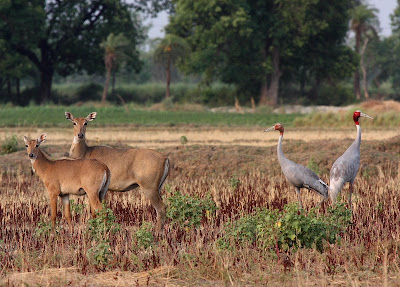 Remember "allopreening"? One bird preens the other as opposed to itself. See the Munia blog entry for an example. This behaviour has been studied by ornithologists quite a bit and general consensus is that it serves to reinforce bonding and is therefore commonly seen during courtship. Some groups of birds allopreen more than others - Black-necked Storks are not among those that are known to indulge in this behaviour. The photo above shows 4-5 month old Black-necked Stork chicks allopreening. In nearly 8 years of observing this species, this is the first time I saw this behaviour. Chicks in the nest are terribly aggressive to each other as they fight for parents' attention and compete for food. Wonder why they need to indulge in this behaviour after fledging from the nest. (Photo taken in Etawah district, Apr 7, 2009)
Remember "allopreening"? One bird preens the other as opposed to itself. See the Munia blog entry for an example. This behaviour has been studied by ornithologists quite a bit and general consensus is that it serves to reinforce bonding and is therefore commonly seen during courtship. Some groups of birds allopreen more than others - Black-necked Storks are not among those that are known to indulge in this behaviour. The photo above shows 4-5 month old Black-necked Stork chicks allopreening. In nearly 8 years of observing this species, this is the first time I saw this behaviour. Chicks in the nest are terribly aggressive to each other as they fight for parents' attention and compete for food. Wonder why they need to indulge in this behaviour after fledging from the nest. (Photo taken in Etawah district, Apr 7, 2009)
BirdFinder – A wordy puzzle for bird nerds
3 weeks ago






























